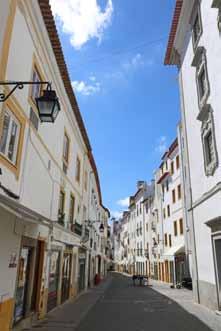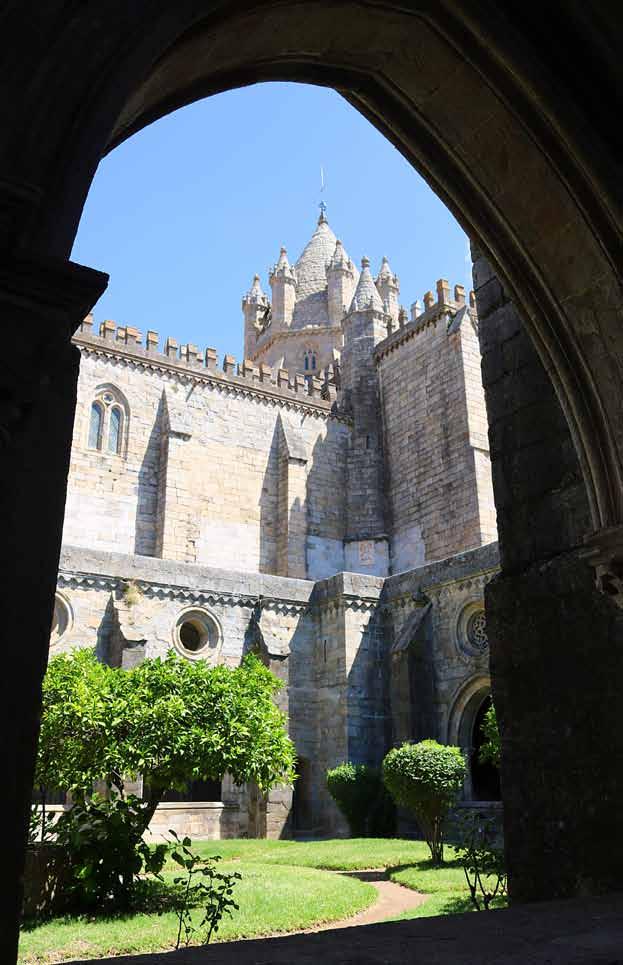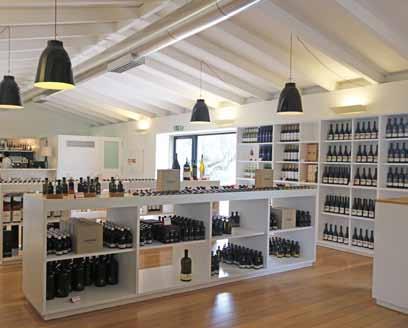
5 minute read
the Alentejo
Our journey to visit Évora
by Helen Gordon
The Alentejo region is vast. Stretching from the Algarve in the south to the Tejo river in the north, the east borders Spain and the west is bathed by the Atlantic Ocean.
On our third visit to this stunning region we decided it was time to travel further and visit the region’s famous capital, Évora, one of Portugal’s most beautifully preserved medieval towns, a two and a half hour pleasant road trip from Fairways.

Dating from the Roman era and now a UNESCO World Heritage Site, we planned a two-night stay to give us plenty of leisure time to explore the home chosen by Portuguese kings in the 15th century. Spared devastation in the 1755 earthquake that levelled Lisbon, contained within Évora’s ancient walls you find Roman ruins, medieval palaces, Gothic religious buildings, cobbled streets and pretty plazas.
We started our visit, after strolling those cobbled streets, with a welcome morning coffee and pastry in the attractive main square and popular gathering space of Praça do Giraldo. Fronted by a Renaissance chapel and encircled by arched buildings, with the morning sun warming us, this was a perfect place to start our exploration. The city is vibrant with a large student population, who attend one of the world’s oldest universities, mingling with locals and visitors alike.
Our next stop was the 13th-century cathedral, regarded as the finest Gothic building in Portugal and largest medieval cathedral. Having visited the Gothic cloisters, we climbed to the terrace to be rewarded with stunning panoramic views over the entire city and beyond.
The famous Roman Temple of Évora, also known as the Temple of Diana, the deity of hunting, stands right in the centre of Évora and is the city’s most famous landmark. Thought to be constructed in the first century, as we stood beneath the 14 imposing pillars we were amazed at how it had survived

O terceiro de uma série de artigos para descobrir o Alentejo
O Alentejo é muito extenso, ocupando todo o território entre o Algarve, a sul, e o rio Tejo, a norte, fazendo também fronteira com a Espanha, a este, e o Atlântico, a oeste. Na nossa terceira visita a esta deslumbrante região, decidimos que era altura de nos aventurarmos um pouco mais e visitarmos a famosa cidade de Évora, uma das mais belas e bem preservadas urbes medievais de Portugal, a duas horas e meia de automóvel do Four Seasons Fairways.
Datada do tempo dos romanos e classificada, hoje em dia, como Património Universal pela UNESCO, planeamos para Évora uma estadia de duas noites para termos tempo suficiente para explorar esta terra eleita como morada dos reis portugueses no século XV. Poupados da devastação do terramoto de 1755 que arrasou Lisboa e delimitados por muralhas antigas, encontramos ruinas romanas, palácios medievais, edifícios religiosos góticos, ruas empedradas e bonitas praças.
Iniciámos a nossa visita, após deambularmos pelas referidas ruas empedradas, com um café e um bolo na atraente Praça do Giraldo, a praça principal e popular local de encontro. Presidida por uma capela renascentista e flanqueada por uma série de edifícios com arcadas, e com o sol a aquecer-nos, este foi sem dúvida o local perfeito so beautifully over so many centuries. Just aweinspiring. para partirmos à descoberta. A cidade é vibrante, albergando uma vasta população estudantil que se mistura com locais e turistas e frequenta uma das mais antigas universidades do mundo.


The next stop was possibly one of the strangest tourist destinations in Portugal, the Capela dos Ossos (Chapel of Bones). By the 16th century, the 43 cemeteries in and around the city were taking up valuable land, so the monks decided to relocate the bones. Designed to provide a place of meditation on life and death, the 5,000 corpses, carefully arranged, cover and decorate the walls, ceiling and columns of the chapel. Although unusual, this is a unique place definitely worth visiting.
A late lunch beckoned us to possibly the most famous restaurant in Évora. Founded in 1945, familyrun Fialho is something of an institution and not to be missed for local Alentejan specialities.
With the heat of the day at its most fierce, we returned to our hotel, the Convento do Espinheiros. Just a five-minute drive outside the city, set in beautiful gardens of olive, fig and pink pepper trees, the hotel’s history includes its 15th-century chapel, visited numerous times by Portuguese royalty. A perfect place to relax and recharge.
With so much to enjoy our visit to the north of the Alentejo gave us fascinating insights into the rich history of Portugal and beauty of the region.
A paragem seguinte foi na catedral do século XIII, considerada um dos expoentes do gótico português e a maior catedral medieval do país. Depois de visitarmos os claustros góticos, subimos ao terraço onde fomos recompensados com uma deslumbrante vista panorâmica sobre a cidade e campos circundantes.
O famoso Templo Romano de Évora, igualmente apelidado Templo de Diana, a deusa da caça, ergue-se precisamente no centro da cidade, sendo um dos seus expoentes. Alegadamente erigido no século I, fascinou-nos, sem dúvida, conforme deambulámos por entre as suas imponentes 14 colunas, não deixando de nos surpreendermos com o facto de ter conseguido sobreviver tão bem durante tantos séculos. É deveras impressionante.

A Capela dos Ossos, a nossa paragem seguinte, é, provavelmente, um dos destinos turísticos mais peculiares de Portugal. No século XVI, os 43 cemitérios existentes na cidade e arredores ocupavam terrenos valiosos, pelo que os monges decidiram realojar os ossos aí existentes. Concebida como local de meditação sobre a vida e a morte, a capela contém cerca de 5,000 esqueletos cuidadosamente dispostos, forrando e decorando paredes, teto e colunas. Apesar de estranho, o lugar merece, sem dúvida, uma visita.
O almoço tardio levou-nos ao que, possivelmente é o mais famoso restaurante de Évora. Fundado em 1945, o Fialho, de gerência familiar, é uma verdadeira instituição; a não perder caso queiram degustar especialidades alentejanas.
Com o calor a apertar, regressámos ao nosso hotel, o Convento do Espinheiro. Situado a cinco minutos da cidade e circundado por um bonito jardim repleto de oliveiras, figueiras e árvores de pimenta rosa, o hotel inclui uma capela do século XV, repetidamente visitada pelos reis portugueses; um lugar perfeito para relaxar e recarregar baterias.
Com tanto para conhecer, a nossa visita ao alto Alentejo proporcionou-nos, sem dúvida, uma fascinante perspetiva da rica história de Portugal e da beleza da região.
Our love of good food and wine demanded that we make a detour on our journey north.
The home of one of our favourite wines, Esporão, was a welcome 30 minute diversion and provided us with a perfect stopping off point for lunch. With a Michelin star restaurant, we dined on topquality locally grown ingredients overlooking their vineyards, olive groves and reservoir.

A nossa paixão por boa comida e bons vinhos exigiu que fizéssemos um desvio de 30 minutos no nosso percurso para Évora.
Casa de um dos nossos vinhos preferidos, o Esporão, a herdade com o mesmo nome proporcionou-nos uma aprazível paragem, perfeita para almoçarmos. O seu restaurante galardoado com uma estrela Michelin deleitou-nos com uma refeição confecionada com excelentes produtos locais e deslumbrantes vistas para os vinhedos, o olival e o lago.










